ImagineMe Mannequin Contest 2013
Created in 2010, this mannequin art competition is designed to promote healthy awareness and acceptance of body image. iaedp invites national art therapists from treatment centers and private practice, students and the public to artistically create mannequins that reflect their perception of beauty and body image.
Judging Criteria
Mannequin entries are judged on clarity of theme, creativity and originality, quality of composition and design, and the overall impression and presentation of the artwork. The contest is open to everyone; however, iaedp encourages treatment centers and private practices with art therapists to work with patients to provide entries.
Each year, poster images of the mannequin entries are displayed gallery-style at iaedp’s Annual Symposium. The Winner, Runner-Up, Honorable Mention and Professional’s Choice are awarded during a special ceremony. The winner receives a financial award along with the image of their mannequin being used in Imagine Me Beyond What You See™ promotions throughout the coming year. For the awards ceremony, the winning mannequin is shipped to the Annual Symposium, unveiled along with the artist(s) and later auctioned off with proceeds to benefit the iaedp Foundation.
Winner, Prefessional’s Choice Award: Can You See Me Now?
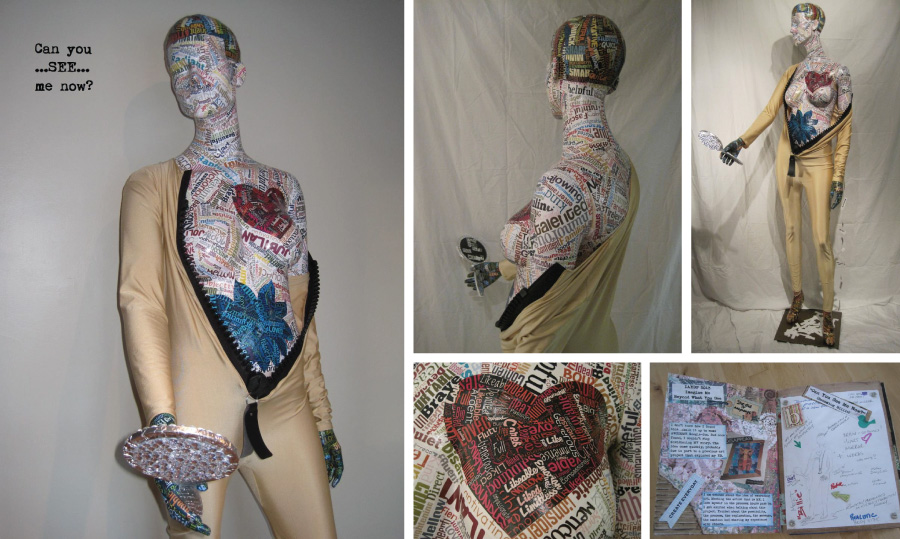
Artist: Jen Foote, MPA – Ottawa, Ontario, Canada
Meet Billie. She is from Montreal. One of only a handful of average-sized mannequins, she came home with me to Ottawa. She is wearing a spandex flesh-coloured body suit with a large, oversized zipper down the front. The body suit is unzipped and pulled off the left shoulder, as if Billie is shedding her skin. The body suit represents her physical body and outward appearance. The large zipper is meant to emphasize the removal of this outer layer.
Underneath this “skin”, the true Billie emerges. She is more than her physical exterior. Her insides are represented by positive coloured words on a black background which focus on a few key areas: her brain, her heart, what she can do with her hands, where she comes from and who she has the potential to be (feet), and her core which is the essence of Billie (belly). Outside these core areas are dozens more positive words. Any one of these words can be used to describe Billie and the beautiful being that she is.
In her right hand is a mirror, but instead of seeing her own image reflected back at her, Billie asks “Can You See Me Now”? She does not look into the mirror to judge her physical self, but to lovingly embrace all that she is which is more than just a body. The mirror itself is pretty and glamorous, not scary and ominous.
Dangling from her left sleeve, as she sheds her skin, are negative words. They are accumulating in a discarded, unwanted pile of black & white at her feet. The words are all face down…the power of words is strong and Billie needs no reminder of the negative words she is shedding. What’s remarkable is the power that this relatively small pile of negative words holds.
Materials:
mannequin, body suit, zipper, hand mirror, paper-mache, mod podge, Wordle, printer paper/ink, stickers, cardstock, paint, rhinestones, tinfoil, glue & transparent thread.
Artist Profile:
Jen Foote, MPA, is in recovery from an eating disorder. Always good with her hands, it was not until last spring that she started to use art to meditate and heal. As a new mixed media artist, Jen further explored the healing properties of art at Brave Girls Camp in Boise, Idaho. It was there that the power of the word truly awakened in Jen a long dormant passion to create. As she continues on her recovery journey, Jen is following a creative path for she believes that “art is her way out.”
Honorable Mention: Blackbird
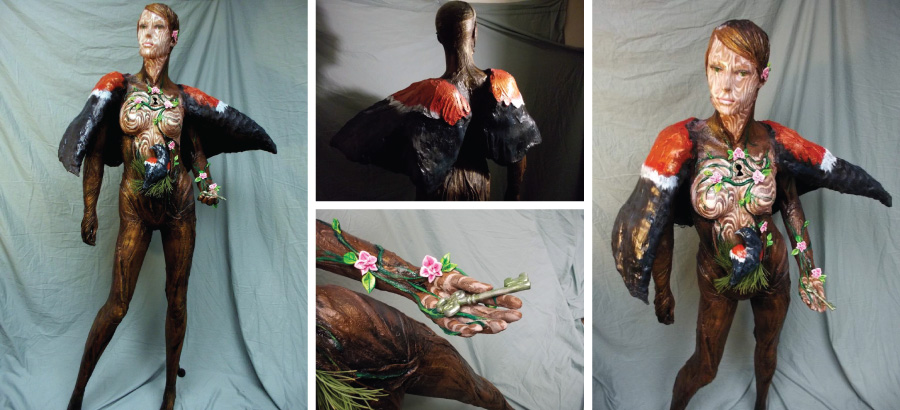
Artist: Katherine D’Orazio – NM
This piece was inspired in part by Paul McCartney’s song lyrics, “Blackbird singing in the dead of night, take these broken wings and learn to fly. All your life…you were only waiting for this moment to be free.”
An eating disorder is a type of prison. Behind its bars, we are as a caged bird. What we don’t realize (or refuse to accept) is that the key to freedom is in our own hands. Freedom is unknown, unsafe, and terrifying. It took years in treatment to find the peaceful, nurturing, protective, aspect within myself (represented by the small, nesting bird). This in turn gave me the strength to unlock the cage of my body image issues and my eating disorder. This work is about making the difficult choice to accept oneself, and fly into freedom and the unknown. – Kat D’Orazio
Materials:
mannequin, plaster gauze and plaster, chicken wire, sculpey, spray paint and acrylic paint
Artist Profile:
Kathleen D’Orazio is a 21 year old artist in recovery from her bulimia nervosa. Her freshman year she had a scholarship to Chicago Art Institute and her bulimia derailed her and sent her back to New Mexico. She entered into treatment with Beth Ellen Hancock, MA, LMHC and Eating Disorders Treatment Center using her art in treatment to help in her healing. She completed EDTC’s Intensive Outpatient Program Fall 2012 and is graduating University of New Mexico this May. She is currently working as an apprentice in a successful tattoo shop in Albuquerque.
Runner Up Award: Blossoming Into Beauty The Journey To Self
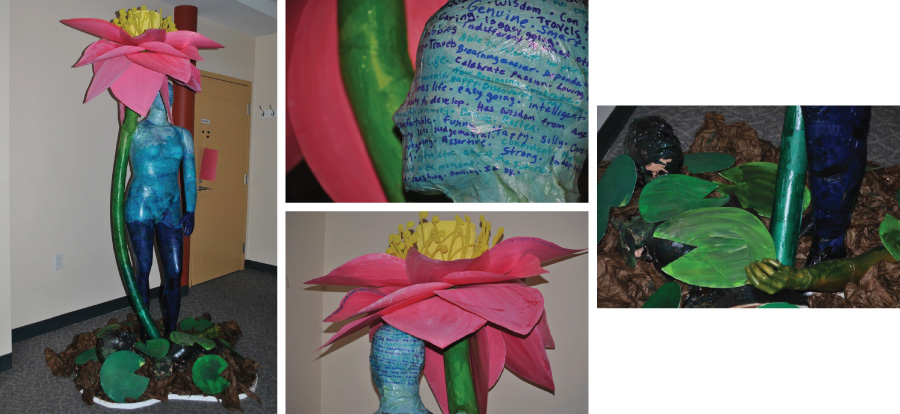
Artist: Cambridge Eating Disorder Center (CEDC) – MA
The lotus flower is symbolic of the human condition across many cultures and religions. With its roots planted solidly at the bottom of a muddy pond, the bud journeys through the water towards the surface and emerges as a pristine blossom. The characteristics of the lotus flower are a perfect analogy for the path of recovery towards a sense of self; it was with this imagery in mind that we created our lotus flower.
In discussing constraints of an eating disorder, we asked, “What would you be free from if you did not have your eating disorder?” In the metaphor of the lotus flower, the mud represents those constraints (anxiety, guilt, depression, isolation, secrecy, etc…) The lily pads and stem represent supports needed along the way; we discussed the difficulty in actually asking for support. Her torso is covered with roadblocks along the journey to recovery (gaining weight, change, mistrust, family, recognizing unhealthy relationships) and the evolution from darkness to light represents how the obstacles get easier to recognize and avoid as the process goes along. The lotus flower blossom represents the freedom that comes with recovery to shape one’s own life. Group members could easily identify what their life could be if they felt beautiful, recovered, free : pamper myself, just be myself, love my imperfections, have a family, able to trust, have a range of feelings, achieve goals, put energy into a different place, follow my dreams, let loose, go to school, have relationships, have a job. Finally, we discussed the qualities that make someone “beautiful” beyond their physical appearance, including a love of life, genuineness, and being at ease with oneself. The central theme that emerged from our discussion was the idea that everyone has a journey which makes them who they are, that journey helps people discover who they are and beauty ultimately comes from knowing and accepting yourself. Blossoming into a sense of self is the realization of the journey.
Materials:
“Plus”and “Normal” size mannequin, plywood sheet, plastic molding, poster board, tissue paper, plumbers epoxy, air –dry modeling clay (for mud in pond), plaster tape, yellow pipe cleaners, oil paint, Mod Podge, 8”x 8” styrofoam block (for pod of flower), tempera paints , magic markers, green swimming “noodle” (for stem)
Artist Profile:
Elizabeth Driscoll, PhD is a psychologist at the Cambridge Eating Disorder Center in Cambridge, MA. Over the course of 3 months, she and individuals attending the Partial Hospitalization and Intensive Outpatient Programs at CEDC created Blossoming into Beauty.
Empty
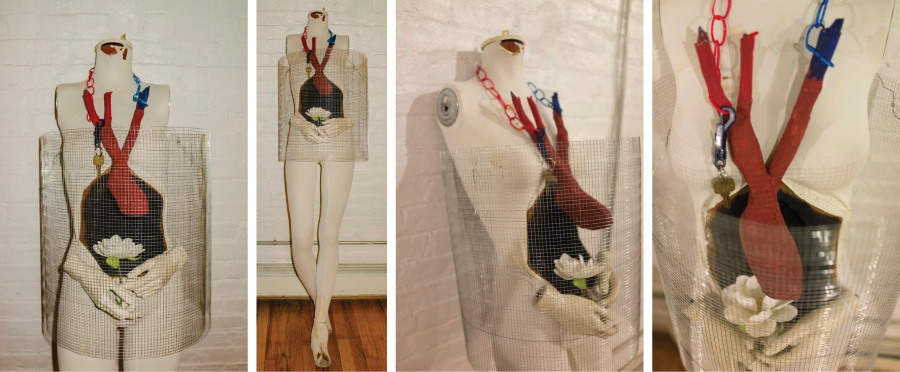
Artist: Casa Rosada – Oliver-Pyatt Centers
“Empty” was created over the course of three months during weekly art therapy sessions. The inspiration behind its creation was to show the emptiness, pain and loss that many people experience during an eating disorder. I wanted my own piece to be a little less colorful and rawer than previous entries having seen them during the course of my own inpatient stays.
Upon standing the mannequin up next to me it became quite apparent how thin she was. Rather than build her up to look more like a normal woman I decided to hollow it out to make the contrast even more striking. The idea of the stomach being “scooped out” and concave was something I had unfortunately aspired to during the depths of my own disorder.
The first piece I constructed was the heart. I believe it’s what’s in the heart that makes someone beautiful: compassion, love, joy, resilience etc. Not the false outward manifestations or your physical appearance.
The cage that surrounds the abdomen is both the actual ribcage and feeling “trapped” in your eating disorder.
As the piece evolved its lack of color became apparent. It is fitting that it is mostly black and white as that is very characteristic of the type of all or nothing thinking experienced while entrenched.
It becomes hard to believe you are not your eating disorder and imagine a future beyond being sick and the emphasis on your body.“Don’t be discouraged, it’s often the last key in the bunch that unlocks the door.”
For myself, like many others, it took multiple treatment approaches for recovery to “click” and this quote helped me combat feelings of failure.
And finally the flower… with each meal complete my life is BLOSSOMING.
Materials:
mannequin, wire, wire mesh, paper-mache, white elastic, paint, key with plastic clip, artificial magnolia flower
Artist Profile:
Madeleine Bowman is in recovery from a decade long struggle with anorexia. She is now an Intern with the National Eating Disorders Association. She is passionate about helping people connect with treatment resources and blessed to be able to give back with her own recovery.
Shannon Bradley ATR, LCAT-Permit is an artist and art therapist living in New York City. Her desire is to support clients in finding greater awareness and self-acceptance, as well as more meaningful, authentic connections with others. Her belief is that each of us has the capacity to be creative and thus to create a life that is more fully in alignment with our true self.
Shannon and Madeleine are connected through outpatient “Experience Wellness Group.” Shannon is Madeleine’s art therapist and they created this piece during a one-on-one session.
True Beauty Has No Label
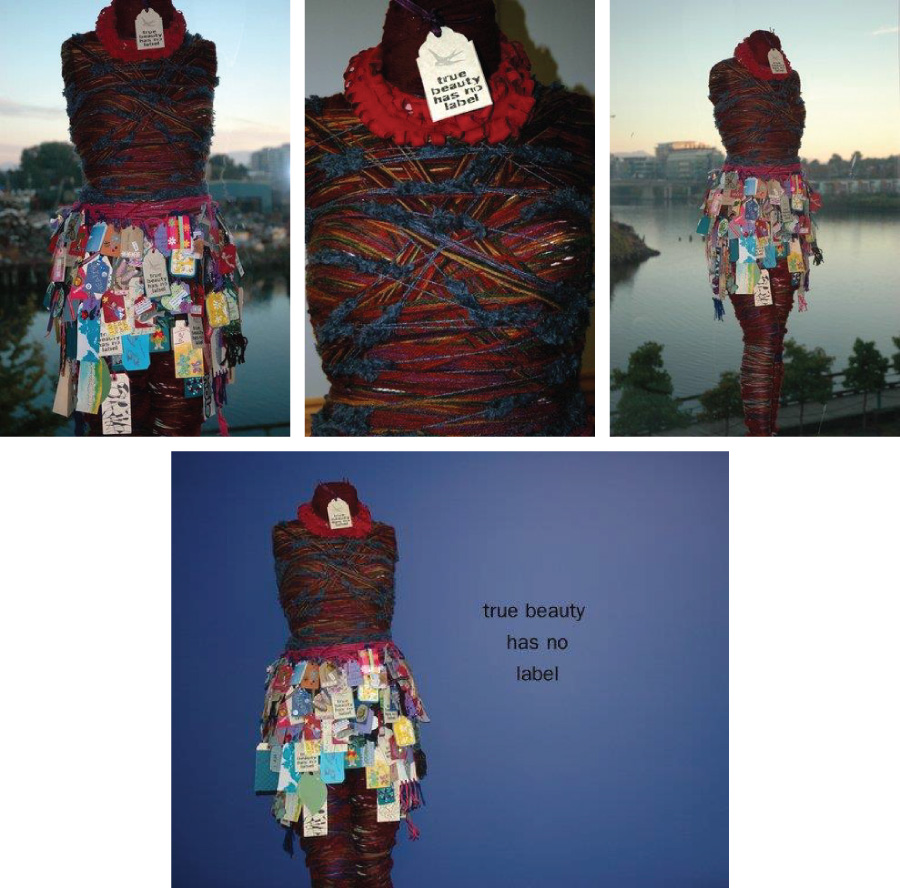
Artist: Art Therapy Practicum Student, Clinicians, Administration Staff and Clients of Eating Disorders Program (Ministry of Child and Youth Mental Health) South Vancouver Island, Victoria, British Columbia
Our aim was to promote healthy awareness and acceptance of body image while also challenging and reconstructing notions of beauty. The mannequin became a platform to rework figurative and commercial ideals of beauty. Our sculpture embraces a more realistic and healthy body image, and fosters a compassionate approach towards the concept of self. The title speaks to the many ways labels can both guide and hinder the progress of recovery, while also asking the question what is beauty to you? Distorted thinking, in terms of eating disorders and in regards to culturally-constructed ideas of beauty, can lead individuals to think in terms of size labels and to scrutinize food labels. Mental health diagnostic labels, socio-cultural labels and stereotypes, can also be a challenging burden. In response, we decided to create labels that would represent our own perceptions of beauty. In doing so, we combined a multifaceted and flexible style of thinking to counter rigid and exclusive concepts. This in turn led to the mannequin being clothed and protected by that which we most valued. The participants worked to sculpt the body of the mannequin, by wrapping plaster casting bandages and grocery bags. The wrapping and smoothing was likened to a healing act of compassion. By covering her in soft wool, it provided a therapeutic experience of nurture and containment, which was both calming and grounding. Aesthetically, the wool adds depth of colour and texture and is transformative. A dull rigid fashion stereotype became a powerful and colourful female form, embodying strength. To fully appreciate the myriad of thoughts represented, one must interact with the artwork and explore its symbolic expressions. She is a place where participants can continue to add their own unique and authentic voice to this collaborative composition and strongly proclaim that True Beauty Has No Label.
Materials:
mannequin, plaster casting, paper, gauze, wool, glue, beads, wire, tape, glitter, felt markers, paint, india ink, stickers, ribbon, multi-media, stencils, card-stock, fabric.
Artist Profile:
“True Beauty Has No Label” is a collaborative project created by a team of artists: clinicians, clients, nutritionists, administration staff and myself (an Art Therapy Intern), at the Eating Disorders Program – South Vancouver Island, Victoria, B.C.
Graffiti Sam
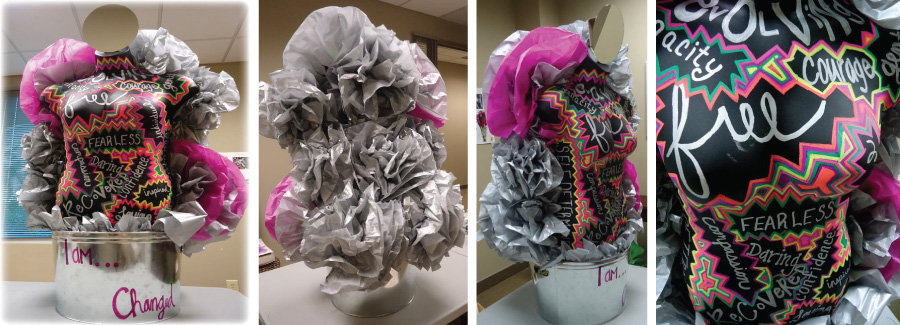
Artist: Carolina House Raleigh – NC, Eva Miller MPS, ATR, LPC
“Graffiti Sam” was created over the span of several months during weekly Art Therapy groups at Carolina House Raleigh. When the therapist introduced the project and mannequin to the group there was initial hesitation and some anxiety about how to effectively transform the materials into a clear and obvious message of wholeness, empowerment, and strength. Although group members changed throughout the weeks, this overall intention of clarity and boldness was forefront throughout. Once the message was identified, brainstorming led to empowering words; bright and graphic shapes; fluorescent colors and a style inspired by pop art, comic books, and street art/graffiti. This style was chosen because of its “in your face” attitude and connotation of rebellion against society. Because the mannequin being used was a shell and hollow on the back/inside, she was filled to overflowing with tissue paper to show that she is not empty, but full, vibrant, and alive. In the very last group, a mirror was added as the face. This choice connects each viewer to the artwork, as they will see their own reflection and be prompted to expand their own sense of self through Graffiti Sam’s message.
Materials:
mannequin, tissue paper, fluorescent sharpie markers, galvanized bucket, wood, mirror
Artist Profile:
This project was created during the weekly Art Therapy Group at Carolina House Raleigh. Carolina House Raleigh is an Intensive Outpatient and Partial Hospitalization eating disorder treatment program for women, ages 17 and up. We are a DBT-informed facility that also uses ACT, CBT, and experiential therapies to create a safe, nurturing, and effective treatment environment for our patients.
Living Idealism: Constructing Destruction
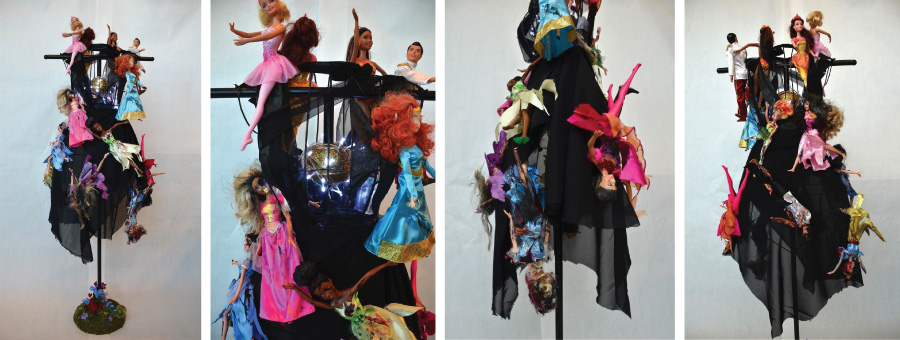
Artist: Eating Recovery Center (ERC) Partial Hospital – CO, Lisa Talucci, MA, ATR, LPC/Art Therapist
Our body is our residence, the framework of our physical existence. We used a mannequin metal body form to show the internal and external aspects of ourselves. At the very core of our essence lives our authentic Self, represented as an illuminated golden sphere, sitting at the heart of internal life. As we grow and develop, we absorb messages of gender biases, social and cultural stereotypes which can seduce us into moving away from our authentic Self toward a false existence. The translucent black fabric represents the way in which we veil our real Self in the process of attempting to be someone other than ourselves.
We used the Barbie and Ken dolls to represent symbols of idealistic representations of female and male stereotypes in rigid roles and appearances. At the top of the mannequin, the Barbie and Ken dolls appear unaltered, which represent our unrealistic aspirations of perfectionism. The Barbie and Ken dolls progressively become more altered, tattered and in a state of destruction. They are losing control, spiraling out and are falling and ‘hanging onto life by a thread’. The figures serve as a symbol of the gradual and inevitable process of destruction that occurs, when we choose, consciously or unconsciously, to live in idealism.
The bottom base of the art is the earth as the garden of life, a symbol of renewal and regeneration. Life continues to invite us to circle through the cycles of beginnings and endings, healing and renewal.
Materials:
mannequin metal dress form, Barbie and Ken dolls, model magic, glitter, LED lights, tissue paper, fabric, paint, markers, scissors, tape, moss, flowers, xacto knife, glue gun.
Artist Profile:
Lisa Talucci, MA, LPC, ATR, RScP is a Psychotherapist, Registered Art Therapist, Spiritual Counselor and artist who has worked with children, adolescents, adults, families and groups for 20 years. She has worked with Eating Recovery Center in Denver, CO since their opening in 2008 as Primary Therapist and Expressive Therapist.
Until Death Do We Part
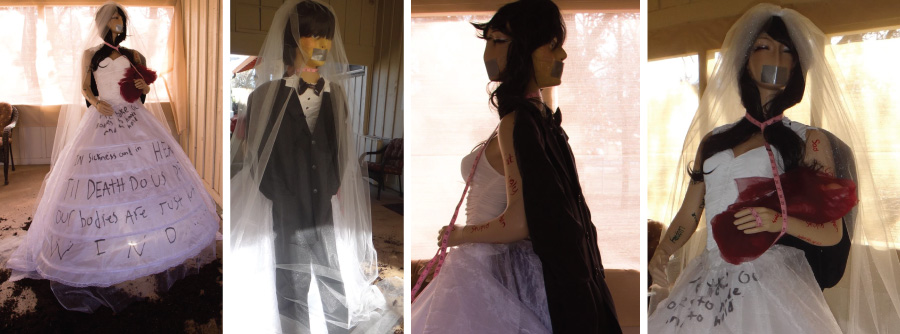
Artist: Project Bliss – TX
Our bodies are with us, to have and to hold, in sickness and in health, until death do we part. This is a marriage that is more permanent than any relationship we may choose with another person. We may decide to love or hate our bodies, but we are together—no matter what. Committing ourselves to honor our bodies unconditionally is to become whole in our lives.
From dirt our bodies came and to dirt they will return—this is an undeniable truth. In the end our bodies really are dust in the wind. Our body is fleeting—it is not who we truly are. It is always in a temporary physical state that is subject to constant change. A life dedicated to this sack of skin is a life wasted—distracted from the real self that resides inside of this vehicle. The body is the vessel for the soul, the body was never meant to be the purpose for the soul.
This piece represents females, males, and even the infant potential of life. Eating disorders do not discriminate, and we can all be vulnerable to some degree. Further, we all possess qualities of the masculine, feminine, and child inside of us. The male part of the mannequin is covered by the bridal veil—this is intended to express the fact that males with eating disorders are often covered-up or overlooked.
The infant potential is encased in the eating disorder. This infant potential can be guided by environment and society to grow into the fulfillment of a life-taking eating disorder. Alternatively this potential can be nurtured to be physically, mentally and emotionally healthy and to fulfill a profound purpose based on true identity.
Materials:
acrylic paint, paint brushes, permanent markers, mannequin, face mask, painted ruched top, hoop skirt, man’s suit, standing light under skirt, masking tape, duct tape, bobby pins, wig, scissors, tulle—veil and dress, soil/dirt, glass stand, markers, memory foam filling, measuring tape , old baby doll
Artist Profile:
Project Bliss is a non-profit, 501(c)3, established by a visionary group of clinicians with the hope of helping to meet the overflowing needs of those struggling with eating disorders. Our artists included males and females of all ages, which provided a diverse base for conceptual ideas. The volunteers for this project envisioned representing both the males and the females who fall prey to this disease. Special thanks to Rachael McBride, Logan M, Rebecca L, Sarah G, Rachel N, Amber, Cyndee A, Parker E, Jeff T, Jennifer Pereira, Roger Pereira.
Uli
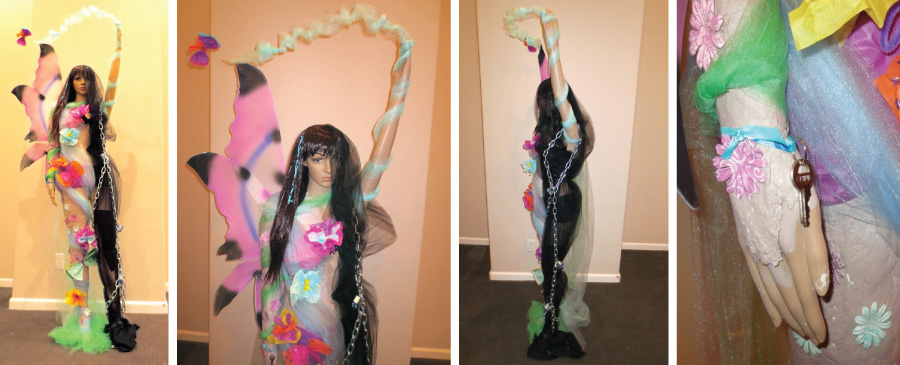
Artist: RainRock Residential Eating Disorder Treatment Center – OR
Clients from RainRock Residential Eating Disorder Treatment Center in Springfield, OR gave life to their artistic vision for IAEDP’s 2013 Imagine Me Body Image Contest. Their dedication and persistence developed this project into a symbolic representation of a concept widely utilized at RainRock known as eating disorder side vs. healthy-self side. This internal conflict is often present within an individual struggling with an eating disorder. Throughout a client’s treatment, staff encourages the healthy self-side to grow and flourish, becoming the prominent voice. The mannequin’s name is Uli, a Hawaiian word meaning the highest manifestation of universal feminine energy and is the goddess of serenity.
The way in which the clients portrayed the eating disorder side vs. healthy-self side was through dividing the mannequin in half. Clients represented the eating disorder side by using black cloth and gauze, representing unbearable emptiness an eating disorder has the capability of evoking. Chains were also used to signify the eating disorder’s prison like feel. The chains were connected with padlocks demonstrating the strenuous fight to break free from one’s eating disorder. A gauze veil was placed over the mannequin’s face, distorting her view of the world.
Clients agreed that the healthy self-side needed a more feminine, curvy figure. Clients used paper plaster to add substance to the underweight mannequin. Once the mannequin had the appropriate volume, clients dressed her in pastel gauze and paper flowers, creating whimsical garb. Butterfly wings were placed on her back to represent growth and freedom from the eating disorder side. Clients wanted to show how change is possible by using blue gauze to connect the two opposing sides. The padlock keys were placed on the healthy self-side’s wrist proving that recovery is possible and the chains can someday be undone.
Materials:
paper plaster, acrylic paint, Tulle (variety of colors), black cotton cloth, tissue paper, glitter, pipe cleaners, chain, padlocks and keys, butterfly wings, ribbon, hot glue, floral wire, wooden clothes pins, felt
Artist Profile:
RainRock Residential Eating Disorder Treatment Center in Springfield, OR treats adult women, 18 and older, experiencing Anorexia Nervosa, Bulimia Nervosa, Eating Disorder Not Otherwise Specified, or Exercise disorders. Eleven clients from RainRock treatment Center participated in IAEDP’s annual Imagine Me Body Image contest. This project took clients approximately a month and half to complete.
A Fractured State of Being

Artist: Rebecca Tishman – MD
It is not about the food on the plate or the number on the scale. It is about so much more; but that is not what most people are taught about an eating disorder. Until trying to recover from mine, I had no idea about the psychological aspects of an eating disorder or the courage and strength it takes to recover from one. The general public and education’s focuses are on the symptoms and side effects of such disorders. For a long time I was ashamed of mine, and not sure how to broach the subject with friends and family. I realized it was not something to be ashamed of that I suffered from an eating disorder. In fact recovering from an eating disorder has been hardest thing I have ever had to do and the fact that I have been able to do so is a cause for celebration. Each day I am reminded of why I am working so hard for this new life I have earned. I have smashed, crushed, and broken dishes. I have reconfigured them into something completely new to show more than just the superficial layer of eating disorders. These disorders are not about vanity and beauty, but rather pain, anguish and feelings of defeat. A life without those feelings is worth fighting for.
Materials:
Female mannequin form, retired dishware, grout
Artist Profile:
Rebecca is a junior Interdisciplinary Sculpture major and the Maryland Institute College of Art. Her work ranges from abstract to realism with a heavy focus on femininity and the female form. She recently celebrated four years of recovery from her eating disorder and continues to share her excitement for her new life through her artwork.
Transcendence
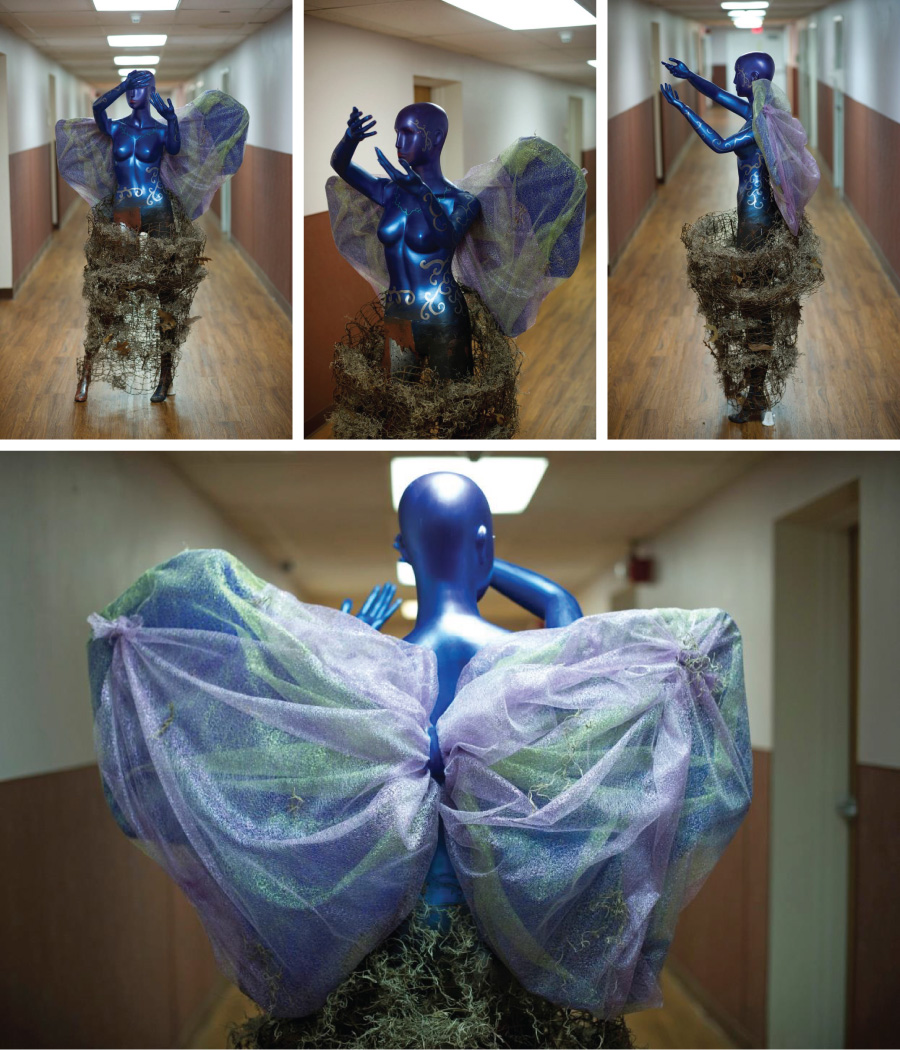
Artist: Reflections Eating Disorder Treatment Program, Dominion Hospital- VA
“Just when the caterpillar thought the world was over, it became a butterfly”, Chinese Proverb – Anonymous
Members of the Reflections Eating Disorder Treatment Program at Dominion Hospital worked closely together to create this year’s response to the theme: ‘Imagine me beyond what you see’. Our group consisted of 9 women and 1 man under the supervision and guidance of 2 creative arts therapists. Through much discussion and brainstorming, we decided upon the metaphor of the butterfly and its journey from the cocoon to freedom. Although we acknowledged that each member of this group is at a different stage of recovery and healing, we recognized that there was a collective theme … the desire for change. We chose to represent the various stages of growth and recovery through the process of metamorphosis. The legs of the mannequin were painted specifically in a manner that was designed to symbolize uncertainty, conflict, ambivalence and confusion; as well as individuality and choices. The cocoon structure represents both the holding environment of treatment as well as the eating disorder itself. The torso was painted in such a way as to reflect the serenity and peace that comes with the acceptance of one’s need for treatment and help. The wings were designed to represent the action of taking flight into a healthier lifestyle. Throughout the creative process, we continued to invite and support the personal stories that arose and were shared amongst the group members. This time together became much more than just an opportunity to ‘make art’ … it provided us with a very real and different way to look at our personal relationship with change and recovery, and it helped us to embody the concept of transcendence.
Materials:
mannequin, acrylic paint, tulle, spanish moss, vine ribbon, cardboard, wire, leaves, rhinestones/sparkles
Artist Profile:
Our mannequin was designed and created by members of the Reflections Eating Disorder Treatment Program at Dominion Hospital in Falls Church, VA, along with two expressive arts therapists. There were 9 females, ranging in age from 14 through 55 and one 18 year old male. The group worked cohesively; incorporating each person’s words and ideas to tell their collective story of the process of unraveling the eating disorder.
Transfiguration: Making Peace with Our Bodies
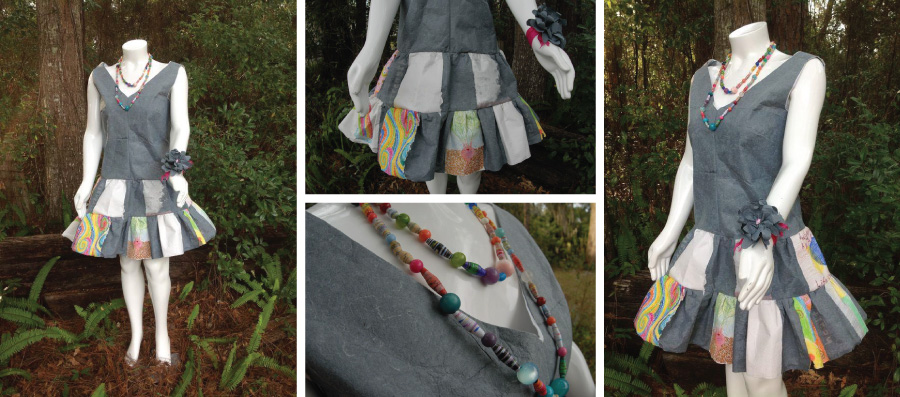
Artist: UF & Shands Eating Disorder Recovery Center – FL, Genevieve Camp, MA, LCAT, ATR-BC in collaboration with Amy Richard, BFA, and Amy Bucciarelli, MS, LMHC, ATR-BC
“Transfiguration” began as a vision I had after attending a workshop where participants made paper from clothes. Hand papermaking seemed to be the perfect way of dealing with those “skinny” jeans that either no longer fit one’s healthier body or are embedded with triggering memories of a painful, eating disordered past. With the help of my collaborators this vision came to life.
EDRC participants began by cutting clothing into pieces which were placed in a beater and broken down into pulp. During this therapeutic deconstructive process individuals shared what it was like to let go of their unhealthy clothes and a greater sense of community developed among the diverse group consisting of both males and females ranging in age from 12 to 66.
Using traditional methods, participants created sheets of handmade paper embedded with words representing themes generated from the group process: energy, peace, health, strength, and love. Once the sheets were pressed and dried, participants drew personal images corresponding to these words. Finally, the sheets of paper were sewn together to become a new garment for our size 16 mannequin. The mannequin was adorned with a necklace of paper beads made from letters that group members wrote to their bodies.
This cycle of taking significant articles of clothing and literally breaking them down to their very fibers, reintegrating the fibers to make paper, and then sewing the paper to make a new garment, serves as a metaphor for the profound transfiguration that happens during the healing process. Part of recovery is recognizing that true beauty exists in our imperfection and brokenness. By accepting and honoring the broken fibers of our being we rediscover our sacred wholeness. “Transfiguration” is about more than just changing the outer appearance; it is about making peace with our bodies and revealing the inner beauty and self-healing nature that is intrinsic to all human beings regardless of size.
Materials:
handmade paper (made from articles of clothing worn by group members), cotton interfacing, cotton thread, oil pastels, colored pencils, markers, paper beads (made from letters written by group members to their bodies), acrylic beads, buttons, and a pink ribbon.
Artist Profile:
The UF & Shands Eating Disorder Recovery Center (EDRC) in Gainesville, FL offers comprehensive and holistic treatment for adolescents and adults with eating disorders at both inpatient and outpatient levels of care.
Genevieve Camp, MA, LCAT, ATR-BC, RYT-200, is a licensed and board certified art therapist and yoga teacher practicing at the EDRC in Gainesville. She has been working in the field of eating disorders for several years and is passionate about using art and yoga to heal the relationship between the body and mind.
Amy Richard, BFA, discovered hand papermaking while teaching drawing at the Glassell School of Art in Houston, Texas and has been fascinated by the process ever since. She is interested in the spiritual and healing qualities associated with handmade paper and is collaborating with others to bring these experiences to the community through workshops and demonstrations.
Amy Bucciarelli, MS, LMHC, ATR-BC is a licensed mental health counselor and board certified art therapist practicing with the Shands Arts in Medicine Program. She is also a lecturer with the University of Florida’s Center for Arts in Medicine in the College for Fine Art.
Lily Rose
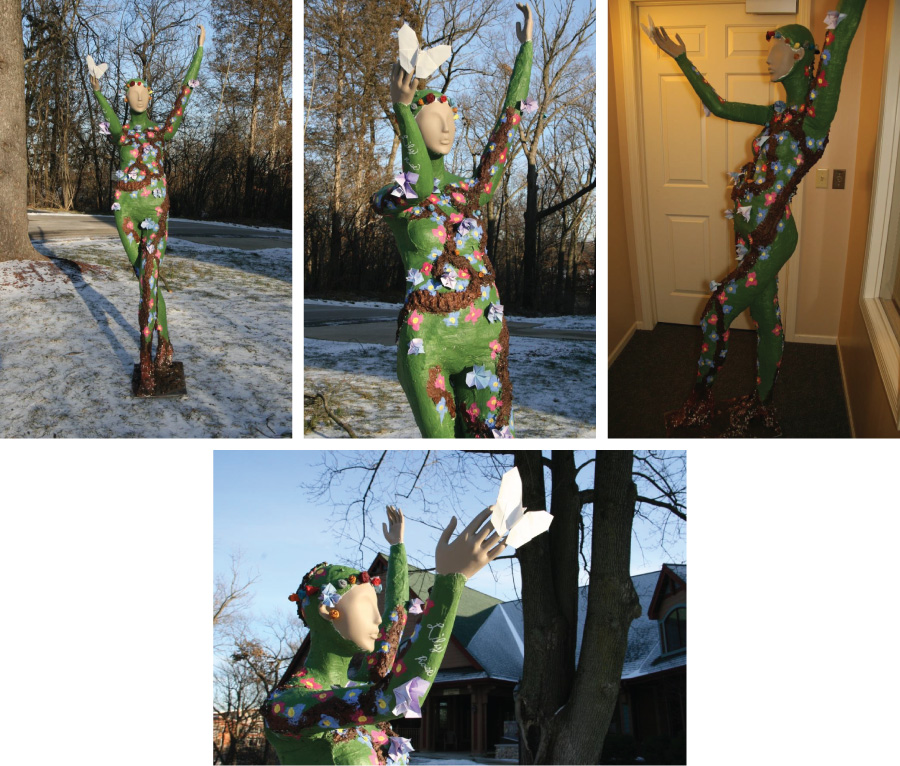
Artist: Rogers Memorial Residential Eating Disorder Program, Adolescent Girls Group – WI, Tina Szada
This art therapy group met every Friday for the last 6 weeks working on the mannequin. The topic of our group was about the significance of creating positive body image. The group worked many weeks on what we called “refeeding” the mannequin because when we received her she was not at her ideal healthy body weight. The group discussed the importance of layering the plaster and how it related to healthy steps towards recovery. As the group worked on layering the plaster there was a lot of conversation regarding what healthy should look like. The group talked about natural beauty as being essential and the reason that the group did not create a face is that they felt individuals can be beautiful without make-up or other beauty products. The theme that would continually come up in the group was about growth. The mannequin is emerging from the dirt into a tree that has many blossoms on her. The dirt that is at the base of the mannequin is dark and unformed, but if it is nourished and nurtured it will grow into a beautiful blossoming tree. The group discussed the importance of having a good foundation to stand on. The butterfly represents purity. This is how a healthy individual can have clarity in their life if they are nourished and care for their bodies. The blossoms symbolize the importance of having positive affirmations that as the individual grows and is nourished, positive affirmations can build self-worth and confidence. The crown of roses represents that each and every person should treat themselves as royalty; the group discussed the importance of feeling good about you both inside and out. The work that the group did with the mannequin benefitted them in the sense that it showed the adolescents how things can change through a process as well as things can be accomplished with support of others.
Materials:
female mannequin, acrylic paint, origami with watercolor paper, plaster gauze, wire, Sculptamold, Sculpey
Artist Profile:
The group that created Lily Rose met every Friday. The group was called mindful art. The group consisted of 4-5 adolescent girls. We collaborated on how body image impacts us.
Tina Szada, MS, ATR-BC, is a clinical art therapist at The Eating Disorder Center at Rogers Memorial Hospital. She received her Bachelor of Arts and Master of Science degrees in art therapy from Mount Mary College in Milwaukee. Ms. Szada has been in the health care field for more than 15 years, working with children, adolescent and adult clients with cognitive, developmental and physical disabilities. She describes her approach as studio art therapy, in the sense that there is an intention that the client creates which is then transformed into an art form.





